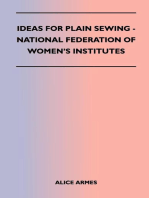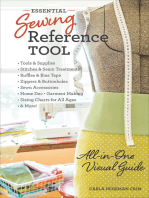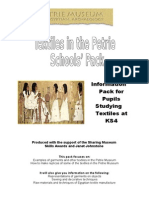0 ratings0% found this document useful (0 votes)
111 views134 Stitch
134 Stitch
Uploaded by
mylan_ScribdThe following notes have been gathered while attempting to learn stitches and construction techniques in use 200 years ago. The following is in no way a complete report, but only an indication of some techniques observed on extant 18th Century Garments. RUNNING STITCH Found on: 1) Essex I nst., Acc. #108352 -- Child's Dress: Side seam worked in running stitch.
Copyright:
© All Rights Reserved
Available Formats
Download as PDF, TXT or read online from Scribd
134 Stitch
134 Stitch
Uploaded by
mylan_Scribd0 ratings0% found this document useful (0 votes)
111 views8 pagesThe following notes have been gathered while attempting to learn stitches and construction techniques in use 200 years ago. The following is in no way a complete report, but only an indication of some techniques observed on extant 18th Century Garments. RUNNING STITCH Found on: 1) Essex I nst., Acc. #108352 -- Child's Dress: Side seam worked in running stitch.
Copyright
© © All Rights Reserved
Available Formats
PDF, TXT or read online from Scribd
Share this document
Did you find this document useful?
Is this content inappropriate?
The following notes have been gathered while attempting to learn stitches and construction techniques in use 200 years ago. The following is in no way a complete report, but only an indication of some techniques observed on extant 18th Century Garments. RUNNING STITCH Found on: 1) Essex I nst., Acc. #108352 -- Child's Dress: Side seam worked in running stitch.
Copyright:
© All Rights Reserved
Available Formats
Download as PDF, TXT or read online from Scribd
Download as pdf or txt
0 ratings0% found this document useful (0 votes)
111 views8 pages134 Stitch
134 Stitch
Uploaded by
mylan_ScribdThe following notes have been gathered while attempting to learn stitches and construction techniques in use 200 years ago. The following is in no way a complete report, but only an indication of some techniques observed on extant 18th Century Garments. RUNNING STITCH Found on: 1) Essex I nst., Acc. #108352 -- Child's Dress: Side seam worked in running stitch.
Copyright:
© All Rights Reserved
Available Formats
Download as PDF, TXT or read online from Scribd
Download as pdf or txt
You are on page 1of 8
Stitches and Seam Techniques - #134
Seen on 18th Century Garments in Various Museum Collections
The following notes have been gathered while attempting to learn stitches
and construction techniques in use 200 years ago. The following is in no way a
complete report, but only an indication of some techniques observed on extant
18th century garments.
Hopefully, others who are researching actual garments of the period in
question will also report on their findings, so that comparisons can be made and
a better total understanding achieved.
G. Ferris
July 1980
FromtheOfficeof theNorthwest Territory AlliancePatternmaster Stitches & Seams #134
1997 Northwest Territory Alliance pg. 1/8
BACKSTITCH
Found on:
1) Essex I nst., Acc. #101.920 - Womans Stays of Ticking
fabric: backstitch used to create channels for boning.
2) Essex I nst., Acc. #101.670 - Womans Stays of Linen
(Acc. Card says cotton): backstitch used for channels for
boning.
3) Essex. I nst., Acc. #109.900 - Childs Stays of Linen or Cotton: backstitch used to create
channels for boning.
4) Boston Mus. F. A., Acc. #61.1034 MansWaistcoat, England: Quilted in very fine
backstitch in herringbone pattern (also embroidered).
5) Germantown H.S., Acc. #663 Mans breeches: Side seam, center back seam, crotch
piecing and waist gusset all backstitched.
(The fell seam worked on a number of short gowns in the collection of Chester County
Historical Society uses the backstitch as the first step. Please see listing Fell seam worked on
wrong side of garment.)
RUNNING STITCH
Found on:
1) Essex I nst., Acc. #108352
Childs Dress: Side seam worked in
running stitch.
2) Metropolitan Mus., Acc.
#1974.194.2 Womans Dress,
English 1780-85: Skirt panels joined by running stitch.
3) Williamsburg, Acc. #53l-59 Mans Coat, American: Running stitch used to attach lin-
ing to coat edge.
4) Chester County H.S., Acc. #00/75CLF98 Womans Short Gown: Pleats on back done
by running stitch (pleats overcast down on inside garment).
5) Chester County H.S., Acc. #00/76CLF164 Womans Short Gown: Running stitch
used to sew back pleats.
6) Chester County H.S., Acc. #00/76CLF183 Womans Short Gown: Running stitch used
to sew back pleats (pleats overcast down on inside garment)
7) Germantown H.S. Acc. #511 Womans Short Gown: Running stitch used to sew back
pleats.
FromtheOfficeof theNorthwest Territory AlliancePatternmaster Stitches & Seams #134
1997 Northwest Territory Alliance pg. 2/8
BUTTED SEAMS
(Two sel vedge edges, or two folded
edges, brought together edge to edge
and overcast; join usually lays flat)
Found on:
1) Essex I nst., Acc. #108/177
Womans apron of blue and white
check: Center seam butted.
2) Essex I nst., Acc. #101,033
Womans Dress of 1790-1810:
Piecing on sleeves done by butting and overcasting (seam allowance turned in first).
3) Williamsburg, Acc. #1956 Womans Dimity (embroidered) petticoat: Has a 3 strip near
waist joined to Dimity with a selvedge edge and a folded edge joined by butting (the one raw
edge then overcast).
4) Chester County H.S., Acc. #00/76CLF184 (also 189)Womans Short Gown: Piecing
seam at front (on inside seam allowances folded back and overcast; raw edges then overcast).
5) Germantown H.S., Acc. #353 (or 55-103) Mans Shirt, --also 3rd Shirtwithout num-
ber: Both of these shirts have one side seam of body with selvedges butted together, the over-
casting being done on the right side of the shirts.
(This t ype of seam is commonly seen on old linens, i.e., sheets, tableclothsalso, blankets and
coverlets.)
STAND-UP SEAM
(A seam which is first
joined by running or
backstitch; then turned
in to the line of stitch-
ing and overcast. This
creates a tubular effect.)
Found on:
1) Metropolitan
Museum of Art, Acc.
#38.26aWomans Dress, American, Mid 18c: Center back skirt seam joined by running stitch.
Then, edges folded in to stitching line and overcast. Result: seam stands up 1/4.
FromtheOfficeof theNorthwest Territory AlliancePatternmaster Stitches & Seams #134
1997 Northwest Territory Alliance pg. 3/8
1
2
SEAMS SPREAD OPEN AFTER JOIN IS MADE
Found on:
1) Mt. Vernon (no Acc. Number) G. Washingtons breeches of twill linen: Center front
seam appears to be opened and edges sewn down on inside. (Seen in case at Museum).
2) Chester County H.S., Acc. #00/76CLF183 Womans Short Gown: Piecing on lower
front portion done right sides together, then seam opened and seam allowances folded back,
edges turned under and overcast down.
LAPPEDFELL SEAM
Where a seam in a garment is required, lap one edge over the other for a depth of approx. 1/2.
Fold in the raw edge and overcast (whip) down. Turn garment to other side, fold in edge and
overcast down. Seam finish will appear the same on both right and wrong sides of garment.
Found on:
1) Chester County H.S., Acc #00/76CLF185 Womans Short Gown: The sleeve join
seam is done as described above.
FromtheOfficeof theNorthwest Territory AlliancePatternmaster Stitches & Seams #134
1997 Northwest Territory Alliance pg. 4/8
lap edges
finished
turn work
over
1
2
3
Wrong Side
Edges under-
and overcast
Right Side
Spread Seam
FELL SEAM WORKED ON WRONG SIDE OF GARMENT
Found on:
1) Williamsburg, Acc. #1956.578Womans petticoat of Dimit y: Side seam of garment
joined with fell seam sewn on wrong side (inside).
2) Chester County H.S., Acc. #00/75CLF98 Short Gown: Side seams sewn with back-
stitch, then seam allowance (to one side) turned under and overcast down.
3) Chester County H.S., Acc #00/76CLF164Womans Short Gown: seams same as #2
above.
4) Chester County H.S., Acc #00/76CLF183 Womans Short Gown: Sleeves joined with
running stitch; seam to one side, edges turned under and overcast-done on wrong side.
5) Chester County H.S., Acc. #00/76CLF185Womans Short Gown: Side seams back-
stitched, felled and overcast as in above examples. Seam result 1/4.
6) Chester County H.S., Acc. #00/76CLF184(also 189)Womans Short Gown: Main side
seams and sleeve joins done with backstitch, felled and overcast as above examples.
7) Germantown H.S., Acc. #511Womans Short Gown: Main side seams same as above
examples of seam on short gownsresultant width of seam approx. 1/8.
8) Germantown H.S., Acc. #89-184Mans Shirt: Side seams done with running stitch,
felled and overcast as above examples. Result: 1/8 width.
9) Germantown H.S., Acc. #353 (or 55-103)Mans Shirt: Sleeve seamssame as above.
Result: approx. 1/8 width.
10) Germantown H.S., (No number)Mans Shirt: Sleeve joins done with backstitch and run-
ning stitch, felled and overcast with 1/8 result. Underarm seam done similar ly.
A note from Claudia Kidwel ls article Short Gowns which appeared in DRESS:
Footnote 25 (page 39 or article) The modern technique for making a flat-fell seam (illustrated
in TheFashion Dictionarywritten by Mary Brooks Picken and Published in NewYork, 1957
produces a flatter seam finishing than appears in any of the twenty-eight short gowns. Three
other methods for producing a similar but thicker seam finish were described in the 1840
London publication, TheWorkWomans Guide(pp. 2-3).
FromtheOfficeof theNorthwest Territory AlliancePatternmaster Stitches & Seams #134
1997 Northwest Territory Alliance pg. 5/8
Either running or
backstitch
Overcast stitch
Wrong side Right side
FELL SEAM WORKED ON WRONG SIDE OF GARMENT (cont)
A further note concerning fell seams:
I n Rural Pennsylvania Clothingby Ellen J. Gehret, instructions for making a flat felled
Seam are given on page 24. A question develops as the short gown pictured on pages 42 and
43 of her book, and the mans shirt shown on pages 122 and 124, both have fell seams worked
on the wrong (inside) of the garments, and Gehret gives instructions for another method (a
modern technique?). Why the author chose to ignore the old method is not entirely clear.
However, in talking to Ellen Gehret by phone on two occasions, two items became clear-
er. Ellen Gehret encouraged me to use the method seen on the original garments (this conver-
sation predated any of my research), and also she mentioned that she had not seen personally
the shirts which are shown in the photos from the Germantown H.S.
I leave it to the individual to research and decide for himself on the question of this seam
technique.
WOMENS SLEEVE PLEATS SEWN DOWN
(more usual to seem them left open)
Found on:
1) Metropolitan Mus., Acc. #1974.194.2
Womans Gown, English, figured Chintz.
SLEEVES OF SET-IN TYPE
(SLEEVE AND LI NI NG TREATED AS ONE AND
THEN SEWN I N)
Found on:
1) Essex I nst., Acc. #101,033Womans Dress: Sleeve sewn
in with backstitch.
2) Metropolitan Mus., Acc. #1974.194.2Womans Dress,
English 1780-85: Sleeve sewn in with backstitch.
3) Metropolitan Mus., Acc. #26.38aWomans Dress,
American: Sleeves sewn in with backstitch.
4) Metropolitan Mus., Acc. #38.26aWomans Dress, American, Mid 18c.
FromtheOfficeof theNorthwest Territory AlliancePatternmaster Stitches & Seams #134
1997 Northwest Territory Alliance pg. 6/8
Placelining over
sleeveand work
as onelayer.
FINISHES ON RAW EDGES OF SEAMS
Found on:
1) Essex I nst., Acc. #108352Childs Dress: Seam done with running stitch, then raw edges
overcast together.
2) Chester County H.S., Acc. #00/76CLF184 (also 189)Womans Short Gown: On piec-
ing, raw edges overcast with large overcast stitches.
3) Germantown H.S., Acc. #663Mans Breeches: On center back seam, raw edges overcast
together.
4) Metropolitan Mus., Acc. #CI -64.32.2a(b)Womans Sack Gown of Cotton Chintz:
Armhole seam raw edges turned in and overcast
NARROW HEMS AT EDGES OF GARMENT
Found on:
1) Essex I nst., Acc. #1208352Childs Dress: Hem done by
running stitch.
2) Chester County H.S., Acc. #00/75CLF98Womans Short
Gown: Narrow hems on sleeve ends and hem of garment (1/8
to 1/4)
3) Chester County H.S., Acc. #00/76CLF164Womans
Short Gown: Hems as in No. 2 above.
4) Chester County H.S., Acc. #00/769CLF183Womans Short Gown:--Hems 1/4 done
with overcast stitch.
5) Germantown H.S., Acc. #511Womans Short Gown: Very narrow hems on edges 1/8.
6) Germantown H.S., Acc. #353 (or 55-103) Mans Shirt: Bottom hem 1/8 overcast.
FromtheOfficeof theNorthwest Territory AlliancePatternmaster Stitches & Seams #134
1997 Northwest Territory Alliance pg. 7/8
TOP STITCHING OF SEAMS
Found on:
1) Metropolitan Mus., Acc #147.2Womans Riding Jacket, c. 1775.
2) Metropolitan Mus., Acc. #26.233.9Womans Dressing Gown, French (I ndian Calico):
Backstitch done in red approx. 1 in from seams.
3) Germantown H.S., Acc. #89-184Mans Shirt: Bands of counted backstitching on right
side of garment.
EMBROIDERY ON GARMENTS
Found on:
1) Metropolitan Mus., Acc.
#3895.AWomans Gown, French, linen:
Embroidery very fine chain stitch polychrome.
2) Boston Mus. F.A., Acc. #38.1297Mans
Negligee Cap, France 1750-1800: Embroidery
fine chain stitch.
3) Boston Mus. F.A. Acc. #38.1315Mans
Negligee Cap, Europe 1700-1750: Silk embroidered with straw. Straw looks like gold.
REFERENCES
Arnold, Janet. A Handbook of Costume. MacMillan, N. Y, 1973. (Very helpfulChapter I I
Dating Costumes from Construction Techniques)
Gehret, Ellen J. Rural Pennsylvania Clothing, Being a Study of theWearing Apparel of theGerman
and English Inhabitants Both Men and Women Who Resided in Southeastern Pennsylvania in the
LateEighteenth and Early Ninenteenth Century. Liberty Cap. Books, York, PA , 1976.
Waugh, Norah. TheCut of Womens Clothes 1600-1930. Theatre Arts Books, N.Y., 1968.
(Cutting diagrams, scaled drawings).
Periodicals:
Kidwell, Claudia. Dress. Short Gowns, 1979 (Journal of the Costume Society.)
FromtheOfficeof theNorthwest Territory AlliancePatternmaster Stitches & Seams #134
1997 Northwest Territory Alliance pg. 8/8
You might also like
- Badass BraidsDocument195 pagesBadass BraidsAsociación Cultural de Teatro Musical de Madrid100% (8)
- Pattern Making Software PDFDocument2 pagesPattern Making Software PDFCatarina SousaNo ratings yet
- Carr and Latham's Technology of Clothing ManufactureFrom EverandCarr and Latham's Technology of Clothing ManufactureDavid J. TylerRating: 4 out of 5 stars4/5 (1)
- Woman's Institute Library of Dressmaking - Tailored Garments: Essentials of Tailoring, Tailored Buttonholes, Buttons, and Trimmings, Tailored Pockets, Tailored Seams and Plackets, Tailored Skirts, Tailored Blouses and Frocks, Tailored Suits, Coats, and Capes, Garments for Men and BoysFrom EverandWoman's Institute Library of Dressmaking - Tailored Garments: Essentials of Tailoring, Tailored Buttonholes, Buttons, and Trimmings, Tailored Pockets, Tailored Seams and Plackets, Tailored Skirts, Tailored Blouses and Frocks, Tailored Suits, Coats, and Capes, Garments for Men and BoysRating: 5 out of 5 stars5/5 (4)
- Patternless Sewing Mod Style: Just Measure, Cut & Sew for the Perfect Fit! - 24 Garments for Women and GirlsFrom EverandPatternless Sewing Mod Style: Just Measure, Cut & Sew for the Perfect Fit! - 24 Garments for Women and GirlsRating: 4.5 out of 5 stars4.5/5 (12)
- Reporting On Duty - Grooming & HygineDocument2 pagesReporting On Duty - Grooming & HygineMahmood Al Jabiri100% (2)
- Izzy Top18mos - 5 PDFDocument8 pagesIzzy Top18mos - 5 PDFSierra TerekNo ratings yet
- How to Sew an Apron: A Selection of Aprons for Work and Play - A Dressmaker's GuideFrom EverandHow to Sew an Apron: A Selection of Aprons for Work and Play - A Dressmaker's GuideNo ratings yet
- The Zapp Method of Couture Sewing: Tailor Garments Easily Using Any PatternFrom EverandThe Zapp Method of Couture Sewing: Tailor Garments Easily Using Any PatternNo ratings yet
- Featherweight 221: The Perfect Portable And Its Stitches Across HistoryFrom EverandFeatherweight 221: The Perfect Portable And Its Stitches Across HistoryRating: 5 out of 5 stars5/5 (1)
- The History of Quilts and Patchwork in Europe, Egypt and AmericaFrom EverandThe History of Quilts and Patchwork in Europe, Egypt and AmericaNo ratings yet
- Intermediate Guide to Pattern Fitting and Alteration: 7 Projects and Little-Known Tricks to Fit and Design GarmentsFrom EverandIntermediate Guide to Pattern Fitting and Alteration: 7 Projects and Little-Known Tricks to Fit and Design GarmentsRating: 1.5 out of 5 stars1.5/5 (4)
- Sewing Supplies Handy Pocket Guide: 65+ Tips & Facts for Tools, Notions & MaterialsFrom EverandSewing Supplies Handy Pocket Guide: 65+ Tips & Facts for Tools, Notions & MaterialsNo ratings yet
- Teach Yourself Stitch Craft and Dressmaking: Dressmaking from A-Z: Volume I - Pre-Stitching and Drafting Information, Tips and TechniquesFrom EverandTeach Yourself Stitch Craft and Dressmaking: Dressmaking from A-Z: Volume I - Pre-Stitching and Drafting Information, Tips and TechniquesRating: 2.5 out of 5 stars2.5/5 (4)
- The T-Shirt Quilt Book: Recycle Your Tees into One-of-a-Kind KeepsakesFrom EverandThe T-Shirt Quilt Book: Recycle Your Tees into One-of-a-Kind KeepsakesNo ratings yet
- Sewing Machine Reference Tool: A Troubleshooting Guide to Loving Your Sewing Machine ... Again!From EverandSewing Machine Reference Tool: A Troubleshooting Guide to Loving Your Sewing Machine ... Again!Rating: 5 out of 5 stars5/5 (1)
- Ideas for Plain Sewing - National Federation of Women's InstitutesFrom EverandIdeas for Plain Sewing - National Federation of Women's InstitutesNo ratings yet
- Pattern Fitting and Alteration for Beginners: Fit and Alter Your Favorite Garments With Confidence: Fit and Alter Your Favorite Garments With ConfidFrom EverandPattern Fitting and Alteration for Beginners: Fit and Alter Your Favorite Garments With Confidence: Fit and Alter Your Favorite Garments With ConfidRating: 1 out of 5 stars1/5 (1)
- The Hand-Book of Millinery - Comprised in a Series of Lessons for the Formation of Bonnets, Capotes, Turbans, Caps, Bows, Etc - To Which is Appended a Treatise on Taste, and the Blending of Colours - Also an Essay on Corset MakingFrom EverandThe Hand-Book of Millinery - Comprised in a Series of Lessons for the Formation of Bonnets, Capotes, Turbans, Caps, Bows, Etc - To Which is Appended a Treatise on Taste, and the Blending of Colours - Also an Essay on Corset MakingNo ratings yet
- The Art of Needle-work, from the Earliest Ages, 3rd ed. Including Some Notices of the Ancient Historical TapestriesFrom EverandThe Art of Needle-work, from the Earliest Ages, 3rd ed. Including Some Notices of the Ancient Historical TapestriesNo ratings yet
- The Tunic Bible: One Pattern, Interchangeable Pieces, Ready-to-Wear Results!From EverandThe Tunic Bible: One Pattern, Interchangeable Pieces, Ready-to-Wear Results!Rating: 3.5 out of 5 stars3.5/5 (9)
- Teach Yourself Stitch Craft and Dressmaking Volume IV: Pattern Drafting for Men and Practice Drafts - Trying your hand at drafting shirtsFrom EverandTeach Yourself Stitch Craft and Dressmaking Volume IV: Pattern Drafting for Men and Practice Drafts - Trying your hand at drafting shirtsNo ratings yet
- A Beginner's Guide to Home Sewing: 50 simple fabric projects for every room in the houseFrom EverandA Beginner's Guide to Home Sewing: 50 simple fabric projects for every room in the houseNo ratings yet
- The Art of Sewing and Dress Creation and Instructions on the Care and Use of the White Rotary Electric Sewing MachinesFrom EverandThe Art of Sewing and Dress Creation and Instructions on the Care and Use of the White Rotary Electric Sewing MachinesNo ratings yet
- Essential Sewing Reference Tool: All-in-One Visual GuideFrom EverandEssential Sewing Reference Tool: All-in-One Visual GuideRating: 3.5 out of 5 stars3.5/5 (5)
- Simplified Systems of Sewing Styling - Lesson Six, FittingsFrom EverandSimplified Systems of Sewing Styling - Lesson Six, FittingsRating: 5 out of 5 stars5/5 (1)
- House Aprons and Caps - Instruction Paper with Examination QuestionsFrom EverandHouse Aprons and Caps - Instruction Paper with Examination QuestionsRating: 4.5 out of 5 stars4.5/5 (3)
- How to Make Lingerie - With Information on Stitches, Embroidery and FasteningsFrom EverandHow to Make Lingerie - With Information on Stitches, Embroidery and FasteningsRating: 1 out of 5 stars1/5 (1)
- Intermediate Guide to Serger: Get Better Finishing, Improve Stitch Formation and Troubleshoot EffortlesslyFrom EverandIntermediate Guide to Serger: Get Better Finishing, Improve Stitch Formation and Troubleshoot EffortlesslyNo ratings yet
- Textiles in The Petrie MuseumDocument38 pagesTextiles in The Petrie MuseumJordi Teixidor Abelenda100% (1)
- History of Seminole Clothing and Its Ticolored: DesignsDocument7 pagesHistory of Seminole Clothing and Its Ticolored: DesignsMahima TyagiNo ratings yet
- A History of SmockingDocument6 pagesA History of SmockingCristopher EL100% (1)
- PHIẾU HỌC TẬP SỐ 3- K9Document3 pagesPHIẾU HỌC TẬP SỐ 3- K9Thiện TríNo ratings yet
- ClothesDocument3 pagesClothesJandy C. CabalceNo ratings yet
- Pc5º Clothes VocabularyDocument2 pagesPc5º Clothes VocabularyMaría Elizabeth Saldarriaga SánchezNo ratings yet
- Clothes Reading Comprehension PassageDocument3 pagesClothes Reading Comprehension PassagePuspita DianNo ratings yet
- Draping: Created By-Pragati RastogiDocument17 pagesDraping: Created By-Pragati RastogiPragati RastogiNo ratings yet
- 5-Emirates Duty Free JewelleryDocument20 pages5-Emirates Duty Free JewellerysanazhNo ratings yet
- Tle He Ha9 W3Document4 pagesTle He Ha9 W3308501No ratings yet
- Clothes and Accessories Vocabulary Esl Crossword Puzzle Worksheets For Kids PDFDocument6 pagesClothes and Accessories Vocabulary Esl Crossword Puzzle Worksheets For Kids PDFAndreiaNo ratings yet
- E Brochure-Fdc PDFDocument6 pagesE Brochure-Fdc PDFJahjaNo ratings yet
- Shaving Rubric NewDocument2 pagesShaving Rubric NewIrene Campos-AguirreNo ratings yet
- New Pattern of Uniform For Kendriya Vidyalaya With ImageDocument8 pagesNew Pattern of Uniform For Kendriya Vidyalaya With ImageAyesha HasanNo ratings yet
- Pakistani DesignerDocument6 pagesPakistani DesignerSYED BILAL ALINo ratings yet
- Personal Grooming 2022Document2 pagesPersonal Grooming 2022Alyssa Shao Wen XinNo ratings yet
- 2023 TAILBONE LENGTH HAIR Growth Challenge CalendarDocument3 pages2023 TAILBONE LENGTH HAIR Growth Challenge CalendarAurora AuroraeNo ratings yet
- Unit 4 Workbook ClothingDocument8 pagesUnit 4 Workbook ClothingKevin RodríguezNo ratings yet
- Comparativesandsuperlatives PDFDocument2 pagesComparativesandsuperlatives PDFandresNo ratings yet
- 14th and 15th Century Veil and Hair StylesDocument7 pages14th and 15th Century Veil and Hair StylesJéssica IglésiasNo ratings yet
- Updated BMI Monitoring of Pat Mike R Bartolin 1Document3 pagesUpdated BMI Monitoring of Pat Mike R Bartolin 1Fredimar PatarayNo ratings yet
- Ropa Travesti 2Document20 pagesRopa Travesti 2Manu GomezNo ratings yet
- Lovers PillowDocument5 pagesLovers PillowJelenaNo ratings yet
- Movieland Magazine July 1952 - Marilyn MonroeDocument4 pagesMovieland Magazine July 1952 - Marilyn MonroeHottstuff42100% (1)
- Writing - Point by Point Versus Block MethodDocument4 pagesWriting - Point by Point Versus Block MethodjamalNo ratings yet
- Four Different Types of Business AttireDocument2 pagesFour Different Types of Business Attireal mamunNo ratings yet
- List FeeDocument2 pagesList Feeimyour109No ratings yet
- Vocabulario Ingles CosmetologíaDocument20 pagesVocabulario Ingles CosmetologíaJuanCarlosLayanaParedesNo ratings yet
- Directoire PeriodDocument17 pagesDirectoire PeriodRaj Haldua A. JosephNo ratings yet

























































































